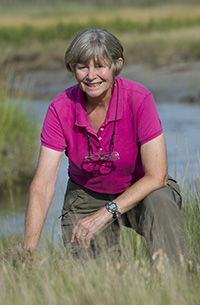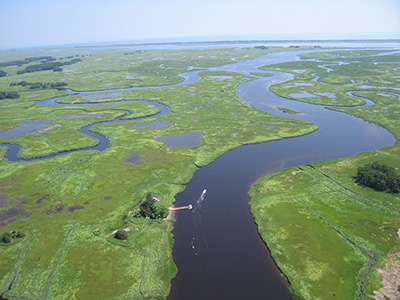NSF Awards Marine Biological Laboratory $6.8 million for Coastal Marsh Research

 Anne Giblin, lead principal investigator of the Plum Island Ecosystems LTER site. Credit: Tom Kleindinst
Anne Giblin, lead principal investigator of the Plum Island Ecosystems LTER site. Credit: Tom KleindinstAnne Giblin, interim director of the Ecosystems Center at the Marine Biological Laboratory, has been awarded a $6.8 million National Science Foundation renewal grant to study how sea-level rise, climate change, and human impacts are reshaping the marshes and estuaries behind Plum Island, Mass., the largest remaining marsh area in the northeastern United States.
Giblin received the grant as lead principal investigator of NSF’s Long Term Ecological Research (LTER) program at Plum Island Sound. Nineteen co-investigators from 13 institutions are studying long-term changes in this interconnected watershed, marsh, and estuarine ecosystem, which bridges land and open sea.
“This is a wonderful honor for the MBL and especially for our Ecosystems group and their colleagues,” said MBL President and Director Hunt Willard. “The LTERs are a critical part of our nation’s system for exploring ecological impact over time, and the MBL Plum Island site is extremely well suited to inform important trends in climate change and its effect on coastal oceans. This program also reflects the MBL’s long history as a convener of biologists from many institutions around the country and the globe.”
 Aerial view of the Plum Island Ecosystems LTER site showing the marsh dotted by many creeks and ponds. At center right is Rowley River, flowing out to Plum Island Sound and the Atlantic Ocean (Gulf of Maine). Plum Island, a barrier island, is visible in the distance between the sound and the ocean. Photo taken in August 2009 at high tide. Credit J.S. Aber, S.W. Aber and V. Valentine
Aerial view of the Plum Island Ecosystems LTER site showing the marsh dotted by many creeks and ponds. At center right is Rowley River, flowing out to Plum Island Sound and the Atlantic Ocean (Gulf of Maine). Plum Island, a barrier island, is visible in the distance between the sound and the ocean. Photo taken in August 2009 at high tide. Credit J.S. Aber, S.W. Aber and V. ValentineA major focus at the Plum Island LTER over the next six years will be changes in the marsh due to sea-level rise, Giblin says. “Will it lead to more open water and changes in vegetation? What will be the impacts on food webs and marsh functions if we do see these changes?”
Sea level has risen an average of 4 mm a year along the northern East Coast over the past two decades, and the rate of rise is projected to increase. How the saltmarsh responds has important implications for humans and for wildlife. The marsh acts as a buffer between residential areas and the ocean, protecting the land from tidal surges due to storms. Plum Island estuaries are also important nursery grounds for fish and major feeding sites for migrating birds.
MBL ecologists have been conducting research at Plum Island Sound since the late 1980s and have directed the Plum Island LTER since its creation in 1998.